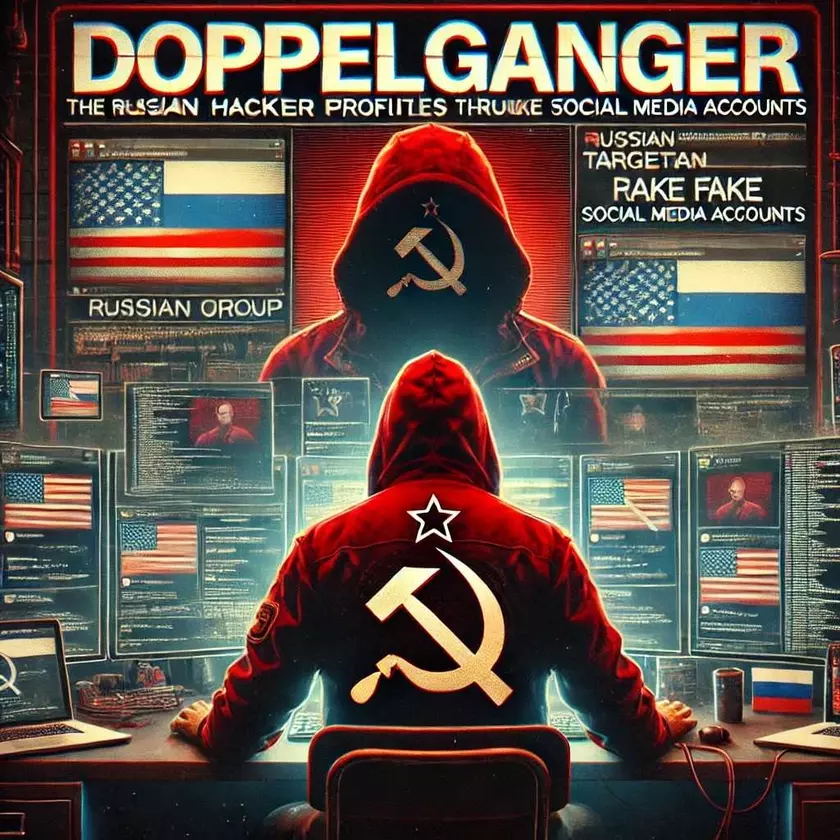Did you think the internet was just a tool for communication? Think again. It's become a battleground for psychological warfare. One of the most insidious threats in this space is Doppelgänger, a Russian disinformation campaign designed to divide Americans against each other by infiltrating social media with fake accounts, inflammatory content, and deceptive narratives.
How Doppelgänger Works: A Masterclass in Digital Deception
Doppelgänger is not a single entity but a coordinated network of fake social media accounts, cloned websites, and AI-powered bots that masquerade as real people and media sources. The goal? To amplify existing societal divisions, provoke outrage, and weaken trust in American institutions.
1. Creating Fake Social Media Accounts
The campaign relies on armies of fake profiles, each carefully crafted to blend into specific communities and interest groups. These accounts:
Use AI-generated profile pictures or stolen images from real users.
Have generic or misspelled names (e.g., “John_Smith77” or “Sarah_Willams” instead of “Williams”).
Lack a verifiable history—often created just weeks or months before they start posting politically charged content.
Follow a mix of real users and other fake accounts to make them seem legitimate.
2. Targeting Polarized Groups
Doppelgänger does not create new issues; instead, it weaponizes existing tensions by tailoring messages to specific audiences. Some tactics include:
For Conservatives: Fake accounts push content suggesting that elections are rigged, crime is out of control, or that the U.S. government is suppressing free speech and religion.
For Liberals: They promote narratives that law enforcement is irredeemably corrupt, that certain groups are perpetually oppressed, or that America’s institutions cannot be reformed but must be dismantled.
For Minority Communities: Bots spread fake news about discrimination, police brutality, or foreign policy decisions to erode trust in the government and law enforcement.
For Veterans & Military Families: They exploit patriotism and distrust of the government by spreading conspiracy theories about military funding, treatment of soldiers, or secret government agendas.
3. Flooding Social Media With Provocative Content
Once these fake accounts gain a following, they unleash a firehose of provocative, misleading, and divisive content. Examples include:
Misleading memes that distort facts about elections, social justice issues, or international conflicts.
Fake news articles cloned from reputable media outlets but edited to contain false or misleading claims.
Manipulated videos designed to make political figures appear incompetent, corrupt, or extreme.
AI-generated comments on high-profile posts, inflaming debates by posing as passionate partisans.
These tactics trap real users into emotionally charged debates, leading them to spread misinformation unknowingly. The more viral the content, the more effective it becomes in shifting public perception.
4. Orchestrating Hashtag Campaigns & Comment Storms
Doppelgänger also manipulates the algorithmic nature of social media by coordinating massive waves of fake engagement. Here’s how:
Coordinated hashtags: Bots push controversial hashtags (e.g., #RiggedElection, #DefundThePolice, #FakePandemic) to make them trend.
Comment storms: Dozens of fake accounts flood the replies of journalists, politicians, or influencers with nearly identical inflammatory comments to create the illusion of widespread sentiment.
Fake influencer personas: Some fake accounts operate like influencers, gaining followers and trust before dropping divisive posts that sway public opinion.
5. Playing Both Sides to Keep the Chaos Going
One of the most devious aspects of Doppelgänger is that it doesn’t favor one political side—it plays both sides to maximize division. For instance:
Fake conservative accounts claim Democrats are destroying the country.
Fake liberal accounts claim Republicans are leading America toward authoritarianism.
Fake “neutral” accounts pose as independent voices but subtly encourage distrust in institutions, media, and the democratic process.
Real-World Impact: How Doppelgänger Has Influenced Americans
This campaign has had real consequences, influencing public discourse, elections, and even protests. Examples include:
2020 Election Interference: Doppelgänger pushed both "election fraud" and "voter suppression" narratives to sow chaos regardless of the outcome.
COVID-19 Misinformation: The network spread contradictory messages—some accounts pushed anti-vaccine propaganda, while others claimed the pandemic was far worse than reported, further dividing the public.
George Floyd Protests: Some fake accounts encouraged violent responses, while others pushed conspiracy theories that the protests were staged.
How to Recognize a Doppelgänger Account
To fight back, you must learn to spot fake social media accounts:
Profile Picture Test: Run the image through a reverse search (like Google Reverse Image or TinEye). If it appears elsewhere, it’s likely stolen or AI-generated.
Posting Patterns: Fake accounts post non-stop, often at all hours, since they operate from different time zones.
Weird Followers & Engagement: They may have lots of followers but minimal personal interactions (no birthday posts, no family pictures, no casual conversations).
Suspicious Language: Awkward phrasing, excessive typos, or a lack of regional slang can indicate a non-native English speaker running the account.
Content Focus: If the account only posts about politics, never about hobbies, family, or daily life, it’s likely fake.
What You Can Do to Stop Doppelgänger
You’re not powerless against this disinformation war. Here’s how to fight back:
Verify Before You Share: Always check multiple sources before sharing sensational news.
Report Suspicious Accounts: If something feels off, report the account to the platform.
Don’t Engage with Bots: Trolls and fake accounts thrive on engagement. Ignoring them weakens their impact.
Educate Others: Talk to friends and family about these tactics so they don’t fall victim.
Conclusion: A Battle for the American Mind
Doppelgänger is not about convincing you to support Russia—it’s about tearing Americans apart from within. By amplifying anger, fear, and distrust, this campaign weakens the U.S. without firing a single bullet.
The best defense? Awareness, critical thinking, and unity. If we recognize and reject these manipulative tactics, we can fight back against the invisible war being waged in our social media feeds.


















